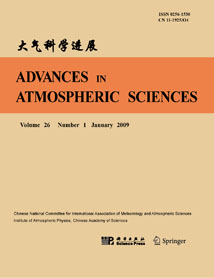| [1] |
Li Jun, Wang Luyi, Zhou Fengxian,
1993: Convective and Stratiform Cloud Rainfall Estimation from Geostationary Satellite Data, ADVANCES IN ATMOSPHERIC SCIENCES, 10, 475-480.
doi: 10.1007/BF02656972
|
| [2] |
Yu Fan, Liu Changsheng, Chen Weimin,
1997: Man-Computer Interactive Method on Cloud Classification Based on Bispectral Satellite Imagery, ADVANCES IN ATMOSPHERIC SCIENCES, 14, 389-398.
doi: 10.1007/s00376-997-0058-1
|
| [3] |
Li Jun, Zhou Fengxian, Wang Luyi,
1992: Automatic Classification and Compression of GMS Cloud Imagery in Heavy Rainfall Monitoring Application, ADVANCES IN ATMOSPHERIC SCIENCES, 9, 458-464.
doi: 10.1007/BF02677078
|
| [4] |
YANG Lu, WANG Zhenhui, CHU Yanli, ZHAO Hang, TANG Min,
2014: Water Vapor Motion Signal Extraction from FY-2E Longwave Infrared Window Images for Cloud-free Regions: The Temporal Difference Technique, ADVANCES IN ATMOSPHERIC SCIENCES, 31, 1386-1394.
doi: 10.1007/s00376-014-3165-9
|
| [5] |
Li Jun, Zhou Fengxian, Gao Qinghuai,
1990: Delineation of Mesoscale Features of Ocean on Satellite IR Image, ADVANCES IN ATMOSPHERIC SCIENCES, 7, 423-432.
doi: 10.1007/BF03008872
|
| [6] |
HUANG Yongjie, CUI Xiaopeng,
2015: Dominant Cloud Microphysical Processes of a Torrential Rainfall Event in Sichuan, China, ADVANCES IN ATMOSPHERIC SCIENCES, 32, 389-400.
doi: 10.1007/s00376-014-4066-7
|
| [7] |
SHEN Xinyong, DING Yihui, ZHAO Nan,
2006: Properties and Stability of a Meso-Scale Line-Form Disturbance, ADVANCES IN ATMOSPHERIC SCIENCES, 23, 282-290.
doi: 10.1007/s00376-006-0282-0
|
| [8] |
Chao Jiping,
1984: DYNAMICS OF LATERAL BOUNDARY MESO-SCALE JET IN THE OCEAN AND ATMOSPHERE, ADVANCES IN ATMOSPHERIC SCIENCES, 1, 199-213.
doi: 10.1007/BF02678132
|
| [9] |
Zhang Yan,
1995: On the Development of Meso-Scale Heavy Rain Parcels in China, ADVANCES IN ATMOSPHERIC SCIENCES, 12, 79-86.
doi: 10.1007/BF02661289
|
| [10] |
ZHAI Guoqing, LI Xiaofan, ZHU Peijun, SHEN Hangfeng, ZHANG Yuanzhi,
2014: Surface Rainfall and Cloud Budgets Associated with Mei-yu Torrential Rainfall over Eastern China during June 2011, ADVANCES IN ATMOSPHERIC SCIENCES, 31, 1435-1444.
doi: 10.1007/s00376-014-3256-7
|
| [11] |
K. D. Prasad, S. V. Singh,
1988: LARGE-SCALE FEATURES OF THE INDIAN SUMMER MON-SOON RAINFALL AND THEIR ASSOCIATION WITH SOME OCEANIC AND ATMOSPHERIC VARIABLES, ADVANCES IN ATMOSPHERIC SCIENCES, 5, 499-513.
doi: 10.1007/BF02656794
|
| [12] |
Li Zhenjun,
1998: Estimation of Cloud Motion Using Cross-Correlation, ADVANCES IN ATMOSPHERIC SCIENCES, 15, 277-282.
doi: 10.1007/s00376-998-0046-0
|
| [13] |
Zhong Shiyuan, Zhou Mingyu, Li Xingsheng,
1987: A NUMERICAL STUDY ON THE MESO-SCALE POLLUTANT DISPERSION OVER A SLOPED SURFACE IN THE STABLE BOUNDARY LAYER, ADVANCES IN ATMOSPHERIC SCIENCES, 4, 300-312.
doi: 10.1007/BF02663600
|
| [14] |
Juan HUO, Yongheng BI, Daren Lü, Shu DUAN,
2019: Cloud Classification and Distribution of Cloud Types in Beijing Using Ka-Band Radar Data, ADVANCES IN ATMOSPHERIC SCIENCES, , 793-803.
doi: 10.1007/s00376-019-8272-1
|
| [15] |
Yue SUN, Huiling YANG, Hui XIAO, Liang FENG, Wei CHENG, Libo ZHOU, Weixi SHU, Jingzhe SUN,
2024: The Spatiotemporal Distribution Characteristics of Cloud Types and Phases in the Arctic Based on CloudSat and CALIPSO Cloud Classification Products, ADVANCES IN ATMOSPHERIC SCIENCES, 41, 310-324.
doi: 10.1007/s00376-023-2231-6
|
| [16] |
Fan Beifen, Ye Jiadong, William R. Cotton, Gregory J. Tripoli,
1990: Numerical Simulation of Microphysics in Meso-β-Scale Convective Cloud System Associated with a Mesoscale Convective Complex, ADVANCES IN ATMOSPHERIC SCIENCES, 7, 154-170.
doi: 10.1007/BF02919153
|
| [17] |
Li Jun, Zhou Fengxian,
1992: On Accurate Detection of Oceanic Features from Satellite IR Data Using ICSED Method, ADVANCES IN ATMOSPHERIC SCIENCES, 9, 373-382.
doi: 10.1007/BF02656948
|
| [18] |
MA Leiming, DUAN Yihong, ZHU Yongti,
2004: The Structure and Rainfall Features of Tropical Cyclone Rammasun (2002), ADVANCES IN ATMOSPHERIC SCIENCES, 21, 951-963.
doi: 10.1007/BF02915597
|
| [19] |
Xiaoli LIU, Kerui MIN, Jianren SANG, Simin MA,
2023: Classification of Hailstone Trajectories in a Hail Cloud over a Semi-Arid Region in China, ADVANCES IN ATMOSPHERIC SCIENCES, 40, 1877-1894.
doi: 10.1007/s00376-023-2156-0
|
| [20] |
ZHANG Chengwei, YU Fan, WANG Chenxi, YANG Jianyu,
2011: Three-dimensional Extension of the Unit-Feature Spatial Classification Method for Cloud Type, ADVANCES IN ATMOSPHERIC SCIENCES, 28, 601-611.
doi: 10.1007/s00376-010-9056-9
|















 AAS Website
AAS Website 
 AAS WeChat
AAS WeChat 
 DownLoad:
DownLoad: